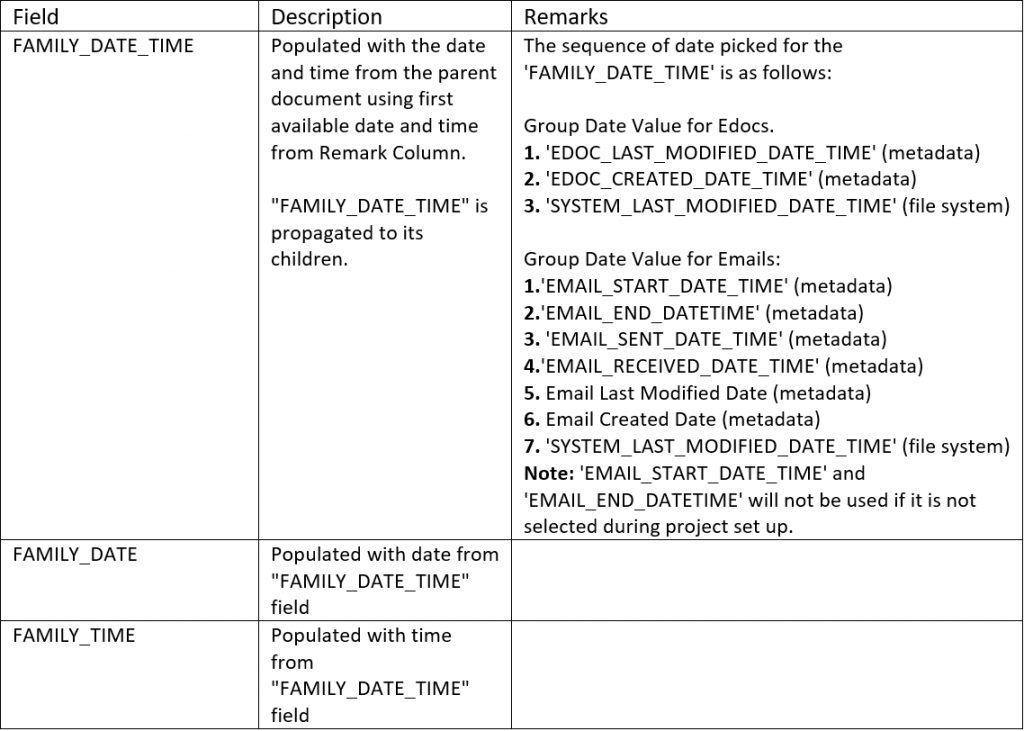
This may sound like a play on words, but when you think about the book or the movie (released in 2012), “What to Expect When You’re Expecting” … it is. But it may also be appropriate to consider that your eDiscovery project is about to give birth through an Exported data set. So, like all parents, we try to prepare ourselves (strollers, diaper bags, bottles, bibs and more) and take some of the lessons learned that we have experienced and share them.
What is Required in the Production
So much can be answered by reviewing the ESI Protocols / Data Exchange Instructions that have been agreed upon by the parties. These instructions can be just a simple list of metadata fields, complex set of instructions for different data types requiring different metadata fields, or output formats. Regardless, this one document is key to any successful production. However, there are times when as a vendor we need to ask for clarification to ensure that what may have just been a boiler plated document is truly what is being asked for. Several of our internal lessons learned really come from these clarifications that we now ask whenever we are doing a production.
Metadata Fields
The VenioOne platform has a number of metadata fields that have different ways of representing the same data. Here are some examples:
a. If you were to ask for a date field, we will want to know if you want to have the Time Component included or just the date itself. Depending on the type of date being asked for, there may be rules that we need to assess to ensure that we are capturing the right date. Here is an example of what we can provide for the FAMILY DATE… (similar date fields exist for EMAIL CREATED, EMAIL START, EMAIL SENT, EMAIL END, EMAIL MODIFIED, EMAIL RECEIVED, EDOC CREATED, EDOC LAST MODIFIED, EDOC LAST PRINTED, SYSTEM LAST ACCESSED, and SYSTEM LAST MODIFIED)

b. If you just ask for the SUBJECT to be provided, we will want to clarify based on the Document Types being exported, EDOC or EMAIL – as there is a different field that we would reference:

Production Output Formats
There are really two aspects to the format: how you want the metadata files to be provided and how you want the actual files to be provided.
Metadata file formats: CSV, DAT, Custom Delimited Format, EDRM Format, LAW EDRM Format, Summation (EDII) Format, and Ringtail (MDB) Format. We typically have our clients asking for DAT and CSV Formatted files.

Data File Export Formats: NATIVE, FULL TEXT (aka OCR), IMAGE (PDF, TIFF, JPG). There are so many different configuration items that can be done within each of these output formats… But in general, we see our clients ask us to provide NATIVE Format for Audio, Video, Graphic, Spreadsheet, and Engineering File Types. The rest of the file types end up having a TIFF Image created (if there is no color found within the document) or a JPG Format (if there is color found within the document).
Redactions: If you have created redactions you will want to make sure that instructions are given to ensure that the Redactions are burned in, and that the FullText (OCR) is regenerated to remove any text that is covered by a redaction.
Slip sheets: These may need to be created when data can not be delivered as part of the export – regardless of the reason (i.e.: Processing Issue; No Text; Being provided in Native Format; Image issues; etc.)

Quality Checks
Most Vendors will do some validation and quality check of the exported data (similar to what we suggest that you may want to do further down). However, when it comes to the IMAGE QUALITY there are a couple schools of thought out there… “Out of the Box Image Quality is Good Enough” and “Every document should be checked to make sure it is an accurate representation of the original document”. The Decision to look at every generated image to ensure quality can come down to a few things:
Number of Documents / Cost considerations / Timing: Its easy to check a few documents; but it takes a long time to check thousands.
The Lawyer in charge of the matter: Do they have a directive to ensure that every document represents the actual look of the original?
Historical experience of legal team: Have you or other team members experienced issues with Imaging, such that you now require every document to be looked at.
Client’s Data types: Maybe the basic documents that you normally work with are not an issue, but when client’s have other file types there may be more issues in how they are presented. (i.e.: some file formats are really XML documents; and when Imaged they end up literally being the TEXT of the XML, vs. what the specific format was supposed to represent – Some Examples include Engineering / Computer Aided Design file types).
Native File: Is it being provided along with the Image? If you are providing the native, then the Image quality may not be an important thing. If they have an issue with the image, they can launch the native and see how it really looked.
Organizing of the Production
Most platforms allow the configuration of how to build the directory structure; the naming convention of the files and so on… Some of our recent projects have needed to be sorted differently. Understanding how the output can be sorted may be something that you would want – maybe GROUP DATE – which would put the documents in order of when they were received/sent/last modified…

Timing
Even with all the directions and confirmations, ultimately it will come down to the number of documents that need to be produced, and the date that it is due. We have experienced requests where small data sets are easily produced within hours/same day, and others where Image Quality is a requirement, and it takes more than a week. In planning for the production (once notified) we try to calculate what the timing is going to look like; and then we discuss with our clients how we can better meet their dates. We may ask about:
Rolling Productions: Can we provide multiple exports without having to resort to different scenarios below.
Parent Only vs. Family Productions: Can we export everything that is NOT part of a Family (i.e., All Email without any Attachments; or all stand-alone eDocs). And then Export the Families as a second export?
Custodian; File Type; or TAG Export Priorities: More ways to breakdown the production into more manageable parts, that may help meet the legal teams needs.
This is not a comprehensive list; it does highlight a number of decisions that we have had to make with our clients. We hope that it raises some additional checks for yourself and your legal team as you plan your ESI Protocol.
Some Tips for your own Validation of what is provided by us or by another vendor can be found in our blog titled: IMPORTant – Import Tips. Specifically, I recommend a good editor and having a basic validation check that you would perform when receiving the data.
Would you like to learn more about our services? Email [email protected] or call 289-803-9730. We’d be happy to share more details about our self-service or fully managed eDiscovery services!
References: Graphic of Dads in: What to Expect When You’re Expecting the Movie (2012). Accessed January 18, 2021: NBCNEWS.com





